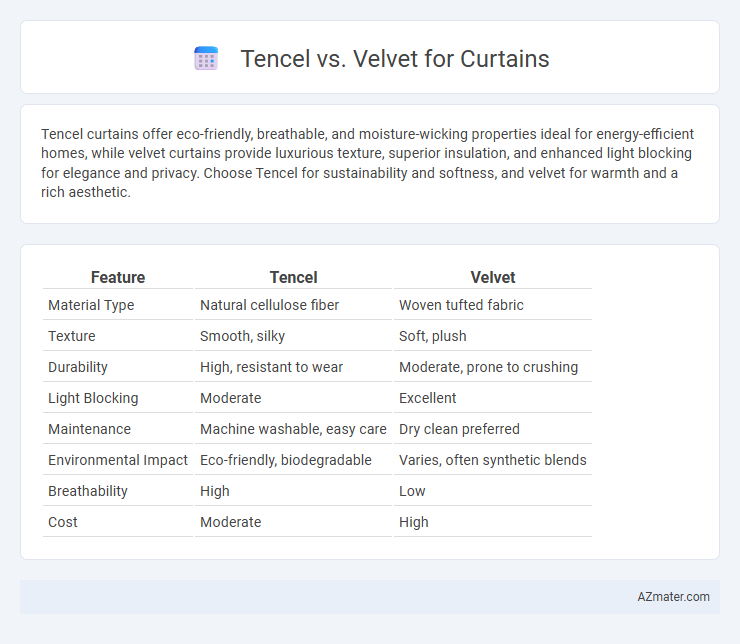Tencel curtains offer eco-friendly, breathable, and moisture-wicking properties ideal for energy-efficient homes, while velvet curtains provide luxurious texture, superior insulation, and enhanced light blocking for elegance and privacy. Choose Tencel for sustainability and softness, and velvet for warmth and a rich aesthetic.
Table of Comparison
| Feature | Tencel | Velvet |
|---|---|---|
| Material Type | Natural cellulose fiber | Woven tufted fabric |
| Texture | Smooth, silky | Soft, plush |
| Durability | High, resistant to wear | Moderate, prone to crushing |
| Light Blocking | Moderate | Excellent |
| Maintenance | Machine washable, easy care | Dry clean preferred |
| Environmental Impact | Eco-friendly, biodegradable | Varies, often synthetic blends |
| Breathability | High | Low |
| Cost | Moderate | High |
Introduction to Tencel and Velvet Curtains
Tencel curtains are made from sustainably sourced wood pulp fibers, known for their softness, breathability, and moisture-wicking properties, making them ideal for eco-friendly and allergy-sensitive homes. Velvet curtains, crafted from dense woven fabrics like cotton, silk, or synthetic fibers, provide a luxurious texture and excellent thermal insulation, perfect for adding elegance and privacy to living spaces. Both options offer unique benefits, with Tencel emphasizing environmental sustainability and comfort, while velvet focuses on rich aesthetics and durability.
Fabric Composition: Tencel vs Velvet
Tencel curtains are made from lyocell fibers derived from sustainably sourced wood pulp, offering a smooth, breathable, and eco-friendly fabric composition ideal for moisture-wicking and durability. Velvet curtains consist of dense woven fibers, typically polyester, cotton, or silk blends, creating a soft, plush texture with a heavier, insulating fabric that enhances room warmth and opulence. The choice between Tencel and velvet hinges on desired fabric properties such as breathability, weight, and environmental impact for curtain applications.
Appearance and Texture Comparison
Tencel curtains boast a smooth, matte finish with a soft, natural drape that enhances modern and minimalist interiors, while velvet curtains offer a rich, plush texture with a luxurious sheen ideal for classic or opulent decor. The silky surface of Tencel feels cool and lightweight, providing a sleek aesthetic, whereas velvet's dense pile creates depth and a tactile warmth that adds visual richness to any room. Both fabrics excel in visual appeal, but Tencel's subtle texture contrasts sharply with velvet's bold, velvety softness.
Durability and Longevity
Tencel curtains offer superior durability due to their moisture-wicking and temperature-regulating properties, making them resistant to wear and fading over time. Velvet curtains provide excellent longevity with their dense weave and heavy fabric, which resist tearing and maintain opacity, ideal for blocking light and enhancing insulation. Choosing between Tencel and Velvet depends on whether a lightweight, breathable drape or a thick, robust fabric is preferred for long-term use.
Breathability and Comfort
Tencel curtains offer superior breathability due to their natural cellulose fibers, allowing better air circulation and moisture absorption, which maintains a fresh indoor environment. Velvet curtains, made from dense, plush fibers, provide a luxurious texture but tend to trap heat and reduce airflow, making them less breathable. For those prioritizing comfort and temperature regulation, Tencel is a more breathable and moisture-wicking option compared to the heavier, warmer velvet fabric.
Maintenance and Cleaning Requirements
Tencel curtains require minimal maintenance, as they are naturally resistant to wrinkles and can be machine washed on a gentle cycle, making them easy to clean and maintain. Velvet curtains, on the other hand, need more careful handling with spot cleaning or dry cleaning recommended to maintain their plush texture and rich appearance. The dense pile of velvet traps dust and allergens, necessitating regular vacuuming to prevent buildup and preserve fabric integrity.
Eco-Friendliness and Sustainability
Tencel curtains, made from sustainably sourced eucalyptus wood pulp, offer superior eco-friendliness due to their biodegradable nature and low environmental impact during production. Velvet, typically composed of synthetic fibers like polyester, involves energy-intensive manufacturing and is less biodegradable, making it less sustainable. Choosing Tencel curtains supports reduced carbon footprints and promotes circular textile economy principles over conventional velvet options.
Light Filtration and Insulation
Tencel curtains offer moderate light filtration with a soft, natural sheen that diffuses sunlight gently, making them ideal for rooms requiring balanced brightness. Velvet curtains provide superior light blockage and thermal insulation due to their dense pile, effectively reducing heat loss and enhancing privacy. Both materials deliver distinct benefits, with Tencel emphasizing breathability and environmental sustainability, while velvet excels in heavy-duty light control and energy efficiency.
Cost and Value for Money
Tencel curtains offer superior breathability and moisture-wicking properties, making them an eco-friendly choice typically priced higher than standard fabrics but delivering excellent durability and comfort. Velvet curtains, known for their luxurious texture and excellent light-blocking capabilities, often come at a premium cost but provide exceptional insulation and a high-end aesthetic that enhances room decor. Evaluating cost versus value for money, Tencel suits buyers prioritizing sustainable and long-lasting materials, while velvet is ideal for those seeking opulence and thermal efficiency despite a steeper price tag.
Which Curtain Fabric is Best for Your Home?
Tencel curtains offer exceptional moisture-wicking properties, breathability, and a soft, natural drape, making them ideal for eco-conscious homes seeking sustainability and comfort. Velvet curtains provide dense insulation, superior light-blocking capabilities, and a luxurious, rich texture, perfect for adding elegance and warmth to living spaces. Choosing between Tencel and Velvet depends on your priorities: Tencel suits airy, energy-efficient designs, while Velvet excels in creating cozy, opulent environments.

Infographic: Tencel vs Velvet for Curtain
 azmater.com
azmater.com